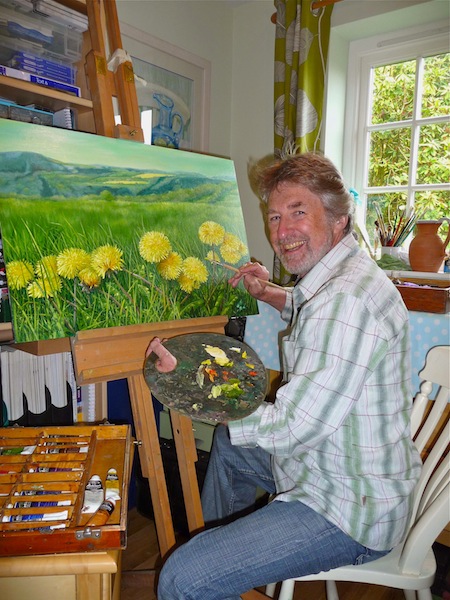Steve Pratchett's landscapes using the mediums of oil pastels and oil paints
Scroll down the page to view my paintings

Steve Pratchett working on an oil painting - "Dandelions Overlooking Gawton'
Introduction
I was trained in Art & Education at Trent Park College, London, specialising in Perspex sculpture from 1967-1971. I lived in the Tamar Valley in Devon for 28 years, where I was a member of the 'Drawn to the Valley' group of artists and a 'Feature Artist' for Pentel who produce Pentel oil pastels. Being designated as an area outstanding natural beauty, the Tamar Valley was an inspiration for many of my landscapes. In 2014 I moved to Norfolk, where big skies and expansive seascapes prevail. I am currently working in the mediums of oil pastels and oil paints. My preferred oil pastels are Caran d"Ache Neopastels although I sometimes combine them with Sennelier.
"If painting seems to be the complete of all
pictorial techniques, then pastel is certainly the most direct. No instrument
as the brush, knife or palette interferes between the artist's gesture and his
work." (Goetz)
My fascination has always been with light and shadow, whether working
with direct light in my Perspex sculptures or in my paintings and oil pastels.
I try to capture the drama and mood that light creates in a landscape.
Feel free to look through my portfolio of work. If you have any questions, you are able contact me through my Contact Me web page. If you wish and you can also visit me on Facebook.
Landscapes in oil pastels & oil paints
Select a thumbnail to enlarge image & use the 'Next' and 'Prev' arrows at the side of the full size image to scroll through the gallery.
Please wait for images to load - time depends on your internet service speed.
Oil pastel: 'Mooring on the River Bure at Buxton Mill' (29cm x 58cm)
All rights copyright the artist. No use of images allowed without expressed consent of the artist.
A brief history of oil pastels
Oil pastels are made from a mixture of wax and oil binder. The latter prevents yellowing with age and gives excellent adhesion properties. They can be used on a variety of surfaces from paper to fabric to wood. Oil pastels are an acid free medium and, although they harden to a small degree, unlike like oil paints, they never crack. Because of their oil and wax mixture, pastels never completely dry so need to be framed behind glass for protection. There are acrylic varnishes that can be used, which give a protective coating that can be wiped clean with a damp cloth and removes the necessity of using glass. However, there is some heated online debate about acrylic varnishes affecting the colour values of oil pastels.
Japan was they "birthplace" of oil pastels. They were invented and developed by the art theorist Yamamoto in collaboration with his two brothers-in-law in 1921. At the Sakura Crayon Company they combined the smoothness texture of crayons and the vibrant colours of pastels to create a new product called Cray-Pas . However, this product was seen only as a suitable medium for children and was never viewed seriously as one for professional artists. Then in 1947 Picasso and Henri Goetz got involved and approached Henri Sennelier to produce a more professional version of Cray-Pas. Picasso was a driving force behind this move, in his own words, wanted "a coloured pastel that I can paint on anything, wood, paper, canvas, metal, etc. without having to prepare or prime the canvas." Goetz also told Sennelier that he would like an oil pastel medium he could use when starting his oil paintings. He felt that the pastel was a more direct medium than applying oil paint by brush, "If painting seems to be the complete of all pictorial techniques, then pastel is certainly the most direct. No instrument as the brush, knife or palette interferes between the artist's gesture and his work."
The collaboration between Picasso, Goetz and Sennelier resulted in the birth of the first professional oil pastel in 1949, the year when I was born! It was Picasso's influence that brought about the unusually wide variety of greys in the Sennelier pastels. Caran d'Ache produced their pastels in 1981, which are my favourites, because of their smooth creamy consistency and vibrant colours. Personally, I find them easier to work with because to me they seem softer and more creamy than other brands and less oily than Sennelier. There are 96 colours in the range of Caran d'Ache Neopastels. Other manufacturers followed by producing their own pastels, resulting in the wide range of brands available today, e.g. Talens, Grumbacher, Pentel, etc. Pentel pastels are the ones I began with in 2009 before moving on to Caran d'Ache Neopastels but I sometimes combine these with Senneliers.
Obtaining Caran d'Ache & Sennelier Oil pastels
Some of the cheaper brands of oil pastels can only be bought in box sets which makes running out of and tern replacing a single colour problematic! With both Caran d'Ache and Sennelier oil pastels there is the advantage that you can order replacement colours individually online. I do so from the online supplier 'GreatArt'.